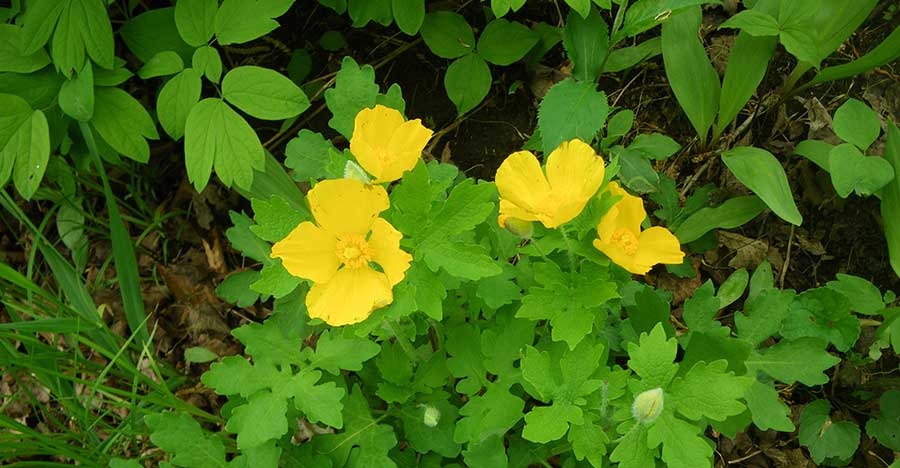Wood-poppy

Introduction
This chapter provides a review of progress toward protection and recovery of Wood-poppy in Ontario from 2007 to 2015.
Species information
Wood-poppy (Stylophorum diphyllum) is a perennial herbaceous plant that grows in rich deciduous forest environments including ravines and along streams. The plant grows up to 40 centimetres high. The leaves are pale underneath and deeply divided into five to seven lobes; most leaves grow at the base of long stalks. In early spring, clusters of showy intense yellow flowers appear at the ends of the flowering stalks. The fruit is a greyish, oval, hairy capsule that splits into three or four segments when ripe. The plant reproduces from a stout rhizome (underground stem). In Canada, Wood-poppy is known only from five small isolated populations occurring in southwestern Ontario, four in the London area, and one population in the Bayfield area near Lake Huron.
Wood-poppy faces several threats to its survival and recovery in Ontario. The main threats are the spread of invasive species (such as Garlic Mustard (Alliaria petiolata) which directly competes with Wood-poppy), erosion of the sites where the plants occur and negative impacts of nearby development and recreation activities. The planting of cultivated Wood-poppy in the wild is another activity taking place in Ontario that could threaten this species. Inter-breeding with wild plants could cause changes in the unique genetic structure of Ontario’s wild Wood-poppy populations.
The survival and recovery of Wood-poppy in Ontario is influenced by other factors as well such as its small population size and low reproduction rates. Because its populations are so small, the species is vulnerable to severe weather or other events, such as erosion, that could cause a significant loss in numbers of individual plants. Also, being at the northern edge of its range, the recovery of Wood-poppy in Ontario is limited by the species’ sensitivity to frost and cold temperatures.
Wood-poppy is listed as endangered at both the provincial (Species at Risk in Ontario List) and federal (Schedule 1 under the Species at Risk Act) levels. Globally, it is considered to be secure.
Provincial status
Prior to the Endangered Species Act, 2007 (ESA or “the Act”), the Committee on the Status of Species at Risk in Ontario (COSSARO) assessed Wood-poppy as endangered, and it was regulated under the previous Endangered Species Act in 1994. Wood-poppy has retained its endangered status under the ESA. In future assessments, COSSARO may consider information gained through protection and recovery actions regarding the species’ threats and trends in population and distribution.
Species and habitat protection
Protecting Wood-poppy and its habitat are key components in the implementation of the ESA, and continue to be government-led actions, as identified in the government response statement. As a species that was regulated under the previous Endangered Species Act, Wood-poppy has received species and habitat protection since 1994. The ESA protects the species from being killed, harmed, harassed, captured or taken and protects its habitat from being damaged or destroyed. Habitat protection under the ESA for Wood-poppy is based on the general habitat definition in the Act, as the ESA does not require a habitat regulation to be developed for transition species
Any person who negatively impacts Wood-poppy or its habitat without prior authorization may be prosecuted under the ESA.
As a species that was regulated under the previous Endangered Species Act, Wood-poppy has received species and habitat protection since 1994. The species is currently protected from being killed, harmed, harassed, captured or taken under the ESA.
In addition, the habitat of Wood-poppy is currently protected from being damaged or destroyed based on the general habitat definition in the ESA.
Recovery strategy
A recovery strategy for Wood-poppy was published on February 18, 2011, which was in advance of the date required by the ESA. Recovery strategies are advice to government and represent the best available scientific knowledge. The strategy identified Wood-poppy habitat needs and the threats that it faces, while recommending objectives and approaches for protecting and recovering the species. The recovery strategy also included recommendations on the areas of habitat to be considered in the development of a habitat regulation.
Government response statement
The Ministry of Natural Resources and Forestry (“the Ministry”) published the government response statement (GRS) for Wood-poppy on November 18, 2011, which was within the timeframe required by the ESA. The GRS is government policy that contains the Government of Ontario’s goal for the recovery of Wood-poppy.
To help achieve this goal, the government leads and supports recovery actions identified in the GRS. Common actions for the government to lead as it works toward achieving a species’ recovery goal are provided in section 2.5 of the Species at Risk Program Status (2008–2015). The GRS for Wood-poppy also lists eight actions the Ministry supports others to undertake for the species. These government-supported actions fall under the objectives identified in the GRS, which are:
Recovery Goal
The government’s goal for the recovery of Wood-poppy is to ensure the persistence of naturally occurring populations of Wood-poppy and its habitat at all known locations.- Improve knowledge of the abundance of Wood-poppy and their natural limiting factors;
- Implement measures to protect and improve populations of Wood-poppy, reduce identified threats and increase the availability of habitat; and
- Increase the awareness of landowners and the neighbouring public of Wood-poppy and the protection of its habitat.
under the previous Endangered Species Act in 1994 and then through the general habitat definition under the current ESA since 2008
Supporting our partners
Supporting partners through the Species at Risk Stewardship Fund, as well as through permits and their associated conditions, is an important government-led action. To-date, no authorizations or regulatory provisions have been issued or registered for the species. Through the Species at Risk Stewardship Fund, the Ministry has supported a total of four projects ($914,750) designed to contribute to the protection and recovery of Wood-poppy. All of these projects targeted multiple species at risk including, Wood-poppy. In addition to the funding provided through the Species at Risk Stewardship Fund, the partners reported that they were successful in securing additional funding ($993,708) from other sources. This amount includes additional funding and in-kind support in the form of time and expertise provided by volunteers.
Ontario’s Invasive Species Act
The GRS for Wood Poppy indicates that invasive species pose a threat to the survival and recovery of the species in Ontario. The provincial Invasive Species Act, 2015 came into force on November 3, 2016 and provides an enabling framework to support the prevention, detection and control of invasive species in Ontario. This framework may support actions to reduce the threats of invasive species on native and at-risk species, including Wood Poppy.
Stewardship partners reported that provincial funding helped them to secure in-kind funding by involving 1,387 individuals who volunteered 19,242 hours of their time toward protection and recovery activities for multiple species at risk, including Wood-poppy, which has an estimated value of $475,565. In addition, the partners reported providing outreach to multiple species at risk, including Wood-poppy, to 29,442 individuals.
The remainder of this section highlights projects conducted by partners supported through the Species at Risk Stewardship Fund and their corresponding government-supported recovery actions.
In 2014, Dr. Jenny McCune, Liber Ero Postdoctoral Fellow at the University of Guelph, developed computer models to predict suitable habitat for eight species of rare Ontario woodland plants. The models can help to identify previously unknown populations of the species. Under testing, the models effectively predicted the distributions of seven of the eight species examined, which led to the discovery of new populations of four of the species (McCune 2016). To build on this research, Dr. McCune obtained stewardship funding
In 2008, Carolinian Canada Coalition (CCC) used a portion of their Species at Risk Stewardship Funding to develop Conservation Action Plans in high priority areas. Conservation Action Plans outline a strategy for managing conservation projects; in particular, the plans encourage teams of practitioners to use the best available information surrounding a conservation issue to build, implement, measure and refine actions that address the issue. CCC, in partnership with many organizations and groups developed the Upper Thames River Conservation Action Plan. Within the plan area, Wood-poppy is identified as a significant species and achieving conservation objectives within the plan would have positive impacts for the species. In the following years, the plan was finalized and actions were implemented. For example, CCC working with the City of London, completed detailed surveys of Wood-poppy and other species at risk, helping to incorporate species at risk recovery needs into city planning. Additionally, CCC developed and distributed various education materials, including habitat stewardship menus and best management practices for species at risk, such as Wood-poppy. These actions contribute to the management of species at risk such as Wood-poppy and also contribute to increasing the awareness of landowners and the neighbouring public of Wood-poppy and the protection of its habitat.
Voluntary landowner participation to protect Wood Poppy
Increasing awareness by promoting the protection and recovery of Wood Poppy to landowners and supporting the securement of habitat though existing stewardship programs are government-supported actions in the GRS. Financial support for the implementation of these actions may be available through participation in the Conservation Land Tax Incentive Program (CLTIP). CLTIP is a voluntary program providing an incentive for landowners, including charitable conservation organizations and conservation authorities, to protect conservation lands that include eligible natural heritage features, such as the habitat of species at risk. CLTIP offers 100 percent property tax exemption on eligible portions of a landowner’s property for the annual (long-term) commitment to the protection and stewardship of conservation lands. One private property with a Wood Poppy population is participating in CLTIP). CLTIP supports the protection and management of existing natural populations of Wood Poppy and their habitats.
Species at Risk Stewardship Fund
-
 $0
$0For Wood-poppy exclusively
-
 $914,750
$914,750For multi-species projects that included Wood-poppy
-
 $993,708
$993,708In additional funding and support
-
 4 projects
4 projectsIncluded the Wood-poppy
-
 1,387
1,387Volunteers
-
 19,242
19,242Volunteer hours
-
 29,442 people
29,442 peopleReceived outreach
Occurrences of Wood-poppy in Ontario
Natural Heritage Information Centre (NHIC)
Three populations
Since 2008, the Ministry has received approximately 53 records of Wood-poppy. These records are based on observations between pre-1900s and 2015. Two populations (Denfield and Bayfield) have been discovered based on records submitted since 2008, when the species became protected under the ESA. It is possible that there are observations of Wood-poppy that have not been submitted to the Ministry. Encouraging the submission of observations of Wood-poppy to the Ministry is included in the GRS as a government-led action.
Everyone is encouraged, or may be required by an authorization or approval, to submit observations of Wood-poppy, as well as every other species at risk, to the Ministry’s Natural Heritage Information Centre for incorporation into the provincial record of observations.
53 Observations of this species were submitted to the NHIC since 2008
Summary of progress toward meeting the recovery goal
Summary of progress
Progress has been made toward all government-led actions and two of the government supported actions outlined in the GRS for Wood-poppy. The Government of Ontario has directly undertaken actions to:
- Encourage submission of Wood-poppy data to the Natural Heritage Information Centre;
- Protect the species and its habitat through the ESA;
- Support partners to undertake activities to protect and recover the species;
- Establish and communicate annual priority actions for support;
- Educate other agencies and planning authorities on the requirement to consider the protection of the species and its habitat; and
- Undertake communications and outreach to increase public awareness of species at risk in Ontario.
Government-supported actions are organized under over-arching recovery objectives. Progress has been made toward two of the government-supported recovery objectives and two of the associated actions that are identified in the GRS for Wood-poppy.
Under the objective to implement measures to protect and improve populations of Wood-poppy, reduce identified threats and increase availability of habitat, initial progress has been made toward one of the three actions:
- As opportunities arise, support the securement of habitat of Wood-poppy through existing land securement and stewardship programs (Action No. 6).
This action has been implemented through landowner participation in the Conservation Land Tax Incentive Program.
Under the objective to increase the awareness of landowners and the neighbouring public of Wood-poppy and the protection of its habitat, initial progress has been made toward one of the two actions:
- Develop and provide information to landowners and local recreational land users to increase awareness and promote protection and recovery of Wood-poppy (Action No. 7).
This action has been implemented through a few projects supported by the Species at Risk Stewardship Fund and through participation in the Conservation Land Tax Incentive Program. Stewardship projects developed and promoted species at risk materials to the general public, as well as to particular landowners and land managers with Wood Poppy on their property.
The recovery goal for Wood-poppy is to ensure the persistence of naturally occurring populations of the species and its habitat at all known locations. Effort made toward the government-led and government-supported GRS actions has helped to make progress toward this goal. In addition, the provincial record of observations indicates that Wood-poppy is exhibiting trends that are consistent with the recovery goal. All three previously known populations of Wood-poppy are still considered extant, and two new populations of Wood-poppy have been recently discovered.
Recommendations
As stated in the GRS, the review of progress toward protecting and recovering Wood-poppy can be used to help identify whether adjustments are needed to achieve the protection and recovery of the species. Based on progress to-date, the overall direction provided in the GRS for Wood-poppy should continue to guide protection and recovery actions for the species, particularly actions identified as high priority in the GRS. Relative to actions that have received a high level of support, the following actions have received support to a lesser degree and may be considered in future decisions regarding the protections and recovery of Wood-poppy:
- Actions for which progress has been limited should be supported in future implementation planning, such as conducting research to better understand the cause of low reproductive success (Action No. 1; High Priority), determine the degree of genetic variability that occurs within and among the Ontario and the United States populations (Action No. 3), manage the habitat of Wood-poppy to control the spread of invasive species, reduce trampling, and increase the availability of sites for Wood-poppy seeds to germinate (Action No. 4, High Priority), as appropriate, augment the Fanshawe population of Wood-poppy with individuals that have been grown in cultivation from native Ontario genetic material (Action No. 5), and educate gardening groups, nurseries and seed suppliers on the negative impacts of planting cultivated Wood-poppy in the wild (Action No. 8);
- Continue to educate and provide information to landowners to increase awareness and promote protection of Wood-poppy (Action No. 7), which may include information on support through existing land securement and stewardship programs (Action No. 6); and
- Limited progress has been made toward monitoring populations of Wood-poppy to detect major fluctuations in population numbers, response to recovery actions and threats (Action No. 2). Future implementation of this action should include monitoring at newly discovered locations to gain further information regarding these populations.
Moving forward, protecting and recovering Wood-poppy will continue to be a shared responsibility that will require the involvement of many individuals, organizations and communities. Financial support for the implementation of actions may be available through the Species at Risk Stewardship Fund or the Species at Risk Research Fund for Ontario. The Ministry can also advise if any authorizations under the ESA or other legislation may be required to undertake a project. By working together, progress can continue to be made toward protecting and recovering Wood-poppy in Ontario.
Summary of progress toward the protection and recovery of Wood-poppy (2007 to 2015)
Provincial status:
- Wood-poppy is classified as endangered under the Endangered Species Act, 2007 (ESA). Wood-poppy was also listed under the previous Endangered Species Act, and has retained the same status since transition to the ESA. Wood-poppy has received species and habitat protection since 1994.
Species-specific documents and guidance published by the government:
- Recovery Strategy for Wood-poppy (Stylophorum diphyllum) (2011)
- Wood-Poppy: Ontario Government Response Statement (2011)
Supporting our partners:
- The Ministry has not issued any authorizations for Wood-poppy and no activities have been registered under the ESA.
- Through the Species at Risk Stewardship Fund, the Ministry of Natural Resources and Forestry (“the Ministry”) has enabled its stewardship partners to conduct a total of four projects ($914,750) that have supported the protection and recovery of multiple species at risk, including Wood-poppy.
- The Ministry’s support helped its stewardship partners to involve 1,387 individuals who volunteered 19,242 hours of their time toward protection and recovery activities for species at risk, including Wood-poppy. The estimated value of these voluntary contributions, as well as additional funding and in-kind support, is $993,708.
- Stewardship partners reported providing outreach on multiple species at risk, including Wood-poppy, to 29,442 individuals.
Occurrences and distribution:
- There are currently five extant populations of Wood-poppy in Ontario (four in the London area and one near Bayfield). Three populations were documented at the time the ESA came into force, and two additional populations have been documented since then.
Related Information
- Categorizing and Protecting Habitat under the Endangered Species Act
- Natural Heritage Information Centre
- Ontario’s Endangered Species Act
- Ontario’s Endangered Species Act Regulation 242/08
- Ontario Recovery Strategy and Government Response Statement for Wood-poppy
- Policy Guidance on Harm and Harass under the Endangered Species Act
- Species at Risk in Ontario List
- Species at Risk Stewardship Fund
References
COSEWIC. 2007. COSEWIC assessment and update status report on the wood-poppy Stylophorum diphyllum in Canada. Committee on the Status of Endangered Wildlife in Canada. Ottawa. vi + 23 pp.
McCune, J.L. 2016. Species distribution models predict rare species occurrences despite significant effects of landscape context. Journal of Applied Ecology doi:10.1111/1365-2664.12702.
Footnotes
- footnote[1] Back to paragraph A "transition species" is a species listed under schedule 1, 3, or 4 of the ESA that has not changed in status since June 2008.